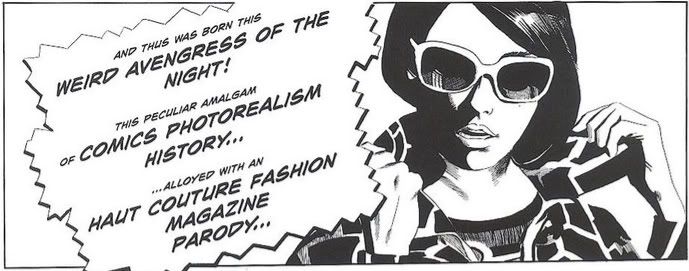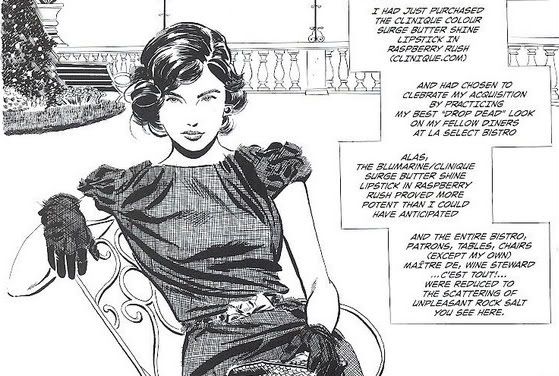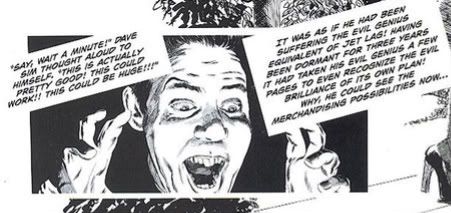I am the beauty of 4/30; hooray for beauty.
/![]() glamourpuss #1:
glamourpuss #1:

This is Dave Sim's new series, in case you hadn't heard. Your $3.00 will get you 24 b&w pages, with future installments to appear bimonthly (with Dave Sim, that's a promise) until the thing's finished. Sim estimates there'll be 20-25 issues in total, but I wouldn't be surprised if changes occur - unless Sim's got a blueprint pinned up somewhere, this is just the sort of project that could flow any which way.
The image above does a pretty good job of teasing the book's concept, but a little extra fleshing-out is warranted. At its core, glamourpuss is a comics-format essay on the 'photorealism' type of newspaper comic strip art, as exemplified by the individual styles of Alex Raymond, Stan Drake, Al Williamson and Neal Adams. Sim loves the stuff, enough so that he wants not only to tell us all about it, but essentially teach himself how to work in that visual mode over the course of his lecture; it's a bit like Lewis Trondheim's famous (and similarly 500-page) 1992 book Lapinot et les carottes de Patagonie, in which the young author forged his signature style -- right in front of his readers' eyes! -- through a long, improvised quest of digressions.
Granted, Sim is a seasoned artist rather than a novice, and he's out to educate us as much as him. As a result, the artist's narration not only hovers around the expected portraits of period notables and the like, but darts inside the word balloons of sample images from pertinent works (Raymond's Rip Kirby is showcased), all of which have been dutifully traced by Sim - no simple reprints here! The work is consequently charged with a special, infectious enthusiasm.
Sim's digressions are a bit different too.

Yes, another one of the artist's working goals is to fulfill his post-Cerebus plan of drawing all the pretty women he wants; as such, big portions of this issue are also traced from fashion magazine ads, for various in-'story' purposes. The term 'glamourpuss' ('glamo[u]r-puss,' 'glamo[u]r puss') is an old one, and Sim uses it both as a general name for most of the models he's appropriated for his study, and as a title for a parodic fashion magazine the comic sometimes pretends to be, although there's also the occasional bit of superhero ballyhoo tossed in, since this is a Direct Market comics pamphlet release and all - Sim even provides an 'origin' sequence, in that he explains how he conceived the project.
All of this adds up to something akin to a movie musical, except instead of a movie it's a comic, and instead of talking people bursting out into song it's a comics history lession bursting out into hilarious gaiety... Dave Sim style. Central to this issue is a six-page sequence titled The Self-education of N'atashae, in which Sim demonstrates how difficult it is to construct an entire comics story out of images traced from preexisting sources - the result functions both as a narration-heavy comedy about a hopelessly smashing model's delusional quest for enlightenment, and a comedic attempt by Dave Sim to hammer out something convincing with whatever scrap he could find containing the same model. He's self-educating too, you see.

I found the book to be far more successful on that latter plane. Even at their best, Sim's jokes about dim fashion plates and the vapidity of materialistic culture amount to targeting an orbital laser cannon on a barrel of fish; when the jokes flop, Sim's tendency to run with his routines -- often over the course of full-page fake ads and spoof articles -- ensures that everything screams to a halt. I also suspect the underlying humor will not sit well with many who've taken great offense to some of Sim's prior works, even before he rolls out a character named "Skanko." And oh boy, she's gonna have a character blog and MySpace (though the series commits the cardinal multimedia faux pas of giving out the addresses before the content is up, which isn't terribly glam at all)!
On the other hand, the "COMIC ART SCHOLARSHIP" part of the legal disclaimer proves to be uniquely subjective in its melding of words and pictures. Sim knows that the eye might zip over his visuals -- his versions of other artists' visuals, actually -- and he sometimes halts the narration to ask you to flip back to a certain page and really look at how he constructed certain images, how he might only use a brush, or how he sometimes resorts to cross-hatching to control visual density. If anything, this comic will show you exactly how much variation can go into 'traced' images through the simple use of differing tools and techniques, and Sim is unfailingly critical of where he feels he's not measuring up to the ideals of Raymond and others.
And even then, the comic reaches one level deeper into the improvisation that can exist in between layers of reproduction. Sim doesn't let us forget that we're not actually seeing the art of Alex Raymond or John Prentice - we're seeing Dave Sim as Alex Raymond or John Prentice, guessing at where fine lines may have been lost from the boards to the page, and grasping for the perfect, inky sheen of his favored masters. Or judging how much detail to omit from those magazine spreads. It's almost maniacally self-conscious, and it encourages the reader to look that much more closely at what they see on the page.
A GOOD effect, although your mileage may vary wildly, depending on your appetite for art process chit-chat and your tolerance for bad jokes; I'll look forward to seeing how it sustains itself over a longer stretch of pages.











